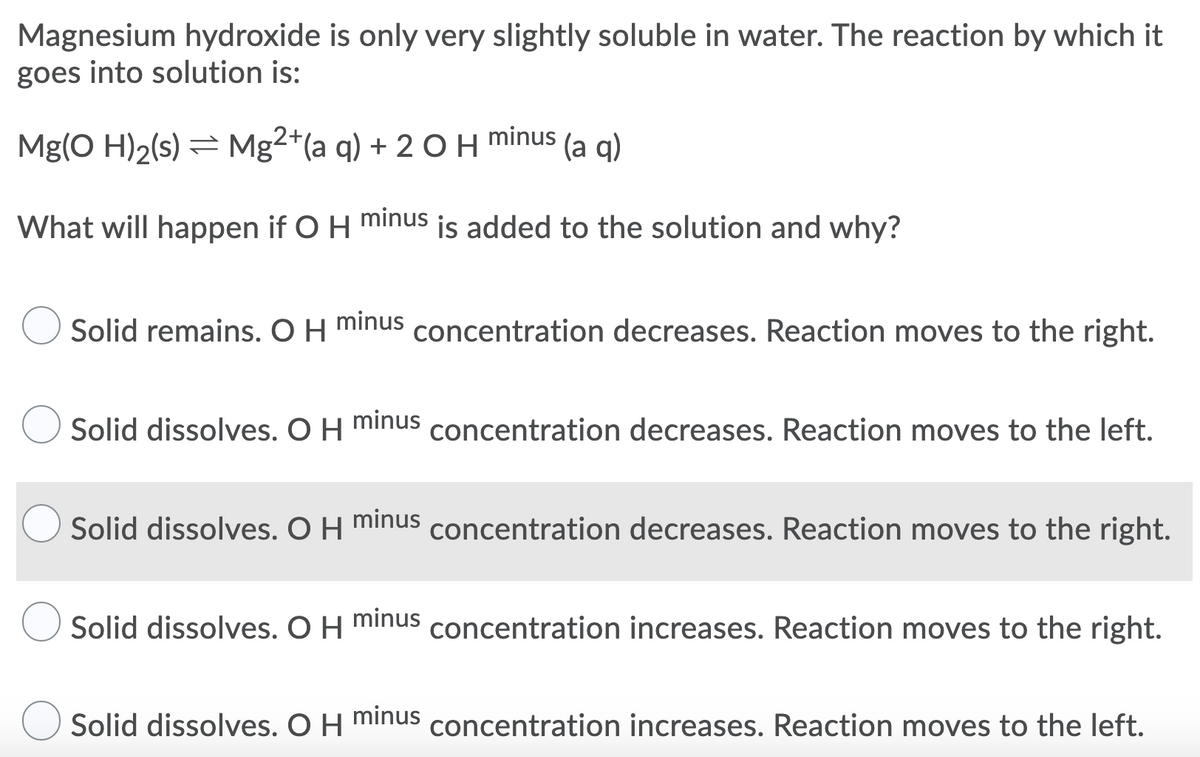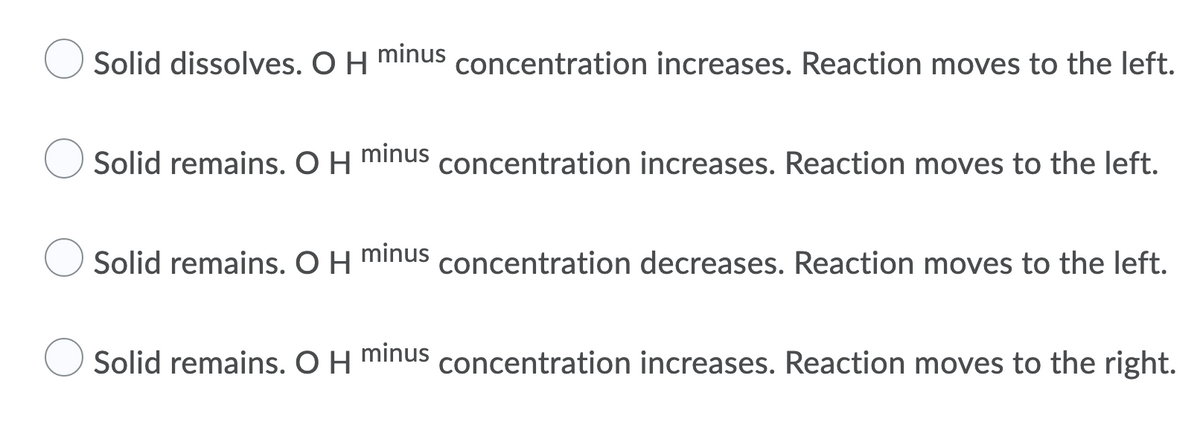Magnesium hydroxide is only very slightly soluble in water. The reaction by which it goes into solution is: Mg(O H)2(s) = Mg2+(a q) + 2 0H minus (a g) What will happen if O H minus is added to the solution and why?
Magnesium hydroxide is only very slightly soluble in water. The reaction by which it goes into solution is: Mg(O H)2(s) = Mg2+(a q) + 2 0H minus (a g) What will happen if O H minus is added to the solution and why?
Chemistry for Engineering Students
4th Edition
ISBN:9781337398909
Author:Lawrence S. Brown, Tom Holme
Publisher:Lawrence S. Brown, Tom Holme
Chapter11: Chemical Kinetics
Section: Chapter Questions
Problem 11.95PAE: The following is a thought experiment. Imagine that you put a little water in a test tube and add...
Related questions
Question

Transcribed Image Text:Magnesium hydroxide is only very slightly soluble in water. The reaction by which it
goes into solution is:
minus
Mg(O H)2(s) = Mg2*(a q) + 2 O H
(а q)
What will happen if O H minus is added to the solution and why?
Solid remains. O H minus concentration decreases. Reaction moves to the right.
Solid dissolves. O H minus concentration decreases. Reaction moves to the left.
Solid dissolves. O H minus concentration decreases. Reaction moves to the right.
Solid dissolves. O H minus concentration increases. Reaction moves to the right.
Solid dissolves. O H minus concentration increases. Reaction moves to the left.

Transcribed Image Text:Solid dissolves. O H
minus
concentration increases. Reaction moves to the left.
minus
Solid remains. O H
concentration increases. Reaction moves to the left.
Solid remains. O H minus concentration decreases. Reaction moves to the left.
minus
Solid remains.OH concentration increases. Reaction moves to the right.
Expert Solution
This question has been solved!
Explore an expertly crafted, step-by-step solution for a thorough understanding of key concepts.
Step by step
Solved in 2 steps with 1 images

Recommended textbooks for you

Chemistry for Engineering Students
Chemistry
ISBN:
9781337398909
Author:
Lawrence S. Brown, Tom Holme
Publisher:
Cengage Learning

Chemistry by OpenStax (2015-05-04)
Chemistry
ISBN:
9781938168390
Author:
Klaus Theopold, Richard H Langley, Paul Flowers, William R. Robinson, Mark Blaser
Publisher:
OpenStax

Introductory Chemistry: A Foundation
Chemistry
ISBN:
9781337399425
Author:
Steven S. Zumdahl, Donald J. DeCoste
Publisher:
Cengage Learning

Chemistry for Engineering Students
Chemistry
ISBN:
9781337398909
Author:
Lawrence S. Brown, Tom Holme
Publisher:
Cengage Learning

Chemistry by OpenStax (2015-05-04)
Chemistry
ISBN:
9781938168390
Author:
Klaus Theopold, Richard H Langley, Paul Flowers, William R. Robinson, Mark Blaser
Publisher:
OpenStax

Introductory Chemistry: A Foundation
Chemistry
ISBN:
9781337399425
Author:
Steven S. Zumdahl, Donald J. DeCoste
Publisher:
Cengage Learning

Introductory Chemistry: A Foundation
Chemistry
ISBN:
9781285199030
Author:
Steven S. Zumdahl, Donald J. DeCoste
Publisher:
Cengage Learning

Chemistry: The Molecular Science
Chemistry
ISBN:
9781285199047
Author:
John W. Moore, Conrad L. Stanitski
Publisher:
Cengage Learning
